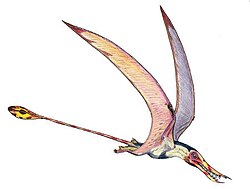Pterosaurs
New taxa
| Name | Status | Authors | Age | Unit | Location | Notes | Images | |
|---|---|---|---|---|---|---|---|---|
Owen | Middle Cretaceous (Turonian) | Unnamed unit in Chalk Group | A dubious pterosaur. | |||||
Valid | von Meyer | Late Jurassic (Kimmeridgian-Tithonian) | A rhamphorhynchid pterosaur. |  | ||||
| List of years in paleontology |
|---|
| (table) |
Paleontology or palaeontology is the study of prehistoric life forms on Earth through the examination of plant and animal fossils . [1] This includes the study of body fossils, tracks ( ichnites ), burrows , cast-off parts, fossilised feces ( coprolites ), palynomorphs and chemical residues . Because humans have encountered fossils for millennia, paleontology has a long history both before and after becoming formalized as a science . This article records significant discoveries and events related to paleontology that occurred or were published in the year 1846.
| Name | Status | Authors | Age | Unit | Location | Notes | Images | |
|---|---|---|---|---|---|---|---|---|
Owen | Middle Cretaceous (Turonian) | Unnamed unit in Chalk Group | A dubious pterosaur. | |||||
Valid | von Meyer | Late Jurassic (Kimmeridgian-Tithonian) | A rhamphorhynchid pterosaur. |  | ||||
| Name | Status | Authors | Age | Unit | Location | Notes | Images |
|---|---|---|---|---|---|---|---|
Valid | Stutchbury | Early Jurassic (Hettangian-Sinemurian) | A rhomaleosaurid plesiosaur; type species of Atychodracon Smith, 2015. | ||||